check engine light Lancia Ypsilon 2011 Owner handbook (in English)
[x] Cancel search | Manufacturer: LANCIA, Model Year: 2011, Model line: Ypsilon, Model: Lancia Ypsilon 2011Pages: 299, PDF Size: 13.35 MB
Page 149 of 299

HOT ENGINE COOLANT
(red)
Turning the key to the MAR-ON position
illuminates the warning light, but it should switch
off after a few seconds. The warning light switches
on (on some versions, with a message on the
display and a symbol on the display) when the
engine is overheated.
If the warning light comes on when driving,
proceed as follows:
❒when driving normally:stop the car, switch
off the engine and check that the water level
in the reservoir is not below the MIN mark. If it
is, wait for a few minutes for the engine to
cool down then slowly and carefully open the
cap, top up with coolant and check that the
level is between the MIN and MAX marks. Also
check visually for any fluid leaks. Go to a
Lancia Dealership if the warning light should
switch on when the engine is started again;
❒if the vehicle is used under demanding
conditions(e.g. towing trailers uphill or fully
loaded): slow down and, if the light stays on,
stop the car. Wait for 2 or 3 minutes with the
engine running and slightly accelerated to
further favour the coolant circulation. Then stop
the engine. Check the correct liquid level as
described above.
IMPORTANT Over demanding routes, it is
advisable to keep the engine on and slightly
accelerated for a few minutes before switching it
off.
FUEL RESERVE – LIMITED
RANGE (amber)
This warning light comes on when about 5 to 7
litres of fuel are left in the tank. When the
remaining range is approx. 50 km (or equivalent
value in miles), on some versions, the display
will show a warning message.
IMPORTANT The warning light will flash to
indicate a system failure. Go to a Lancia
Dealership to have the system checked.
EOBD/INJECTION SYSTEM
FAILURE (amber)
In normal conditions, the warning light switches
on when the key is turned to MAR (on some
versions, with a message on the display), but
should switch off as soon as the engine is started.
147GETTING TO KNOW
YOUR CAR
SAFETY
STARTING AND
DRIVINGWARNING LIGHTS
AND
MESSAGESIN AN
EMERGENCY
SERVICING AND
MAINTENANCE
TECHNICAL
SPECIFICA
TIONS
INDEX
Page 150 of 299

If the warning light remains on or switches on
whilst driving, the injection system is not working
properly; in particular, if the warning light
switches on constantly, this indicates a
malfunction in the supply/ignition system that
could cause excessive exhaust emissions, a possible
loss of performance, poor driveability and high
fuel consumption.
Under these conditions, you may continue
travelling at moderate speed without demanding
excessive effort from the engine. Prolonged use
of the car with the warning light on may cause
damage. Contact a Lancia Dealership as soon as
possible.
The warning light goes out after the fault
disappears, but the notification is stored in the
system.
NOTE (valid only for petrol engines)
If the warning light is flashing, the catalytic
converter could be damaged.
In this case, it is necessary to release the
accelerator pedal to lower the speed of the engine
until the warning light stops flashing; continue the
journey at moderate speed, trying to avoid
driving conditions that may cause further flashing
and contact a Lancia Dealership as soon as
possible.
Go to a Lancia Dealership as soon as
possible if
warning light either does
not light up when the key is turned to
MAR or if while travelling the warning light
comes on either constantly or flashing (along
with a message and a symbol on the display
on some versions). The operation of warning
light
may be checked by the traffic police
using specific devices. Comply with the laws
and regulations of the country where you
are driving.ESC SYSTEM FAILURE (amber)
(for versions/markets, where provided)
This warning light switches on when the ignition
key is turned to MAR, but it should switch off
after a few seconds. If the warning light does not
switch off or remains on (along with a message
and a symbol on the display on some versions)
whilst driving, contact a Lancia Dealership.
Flashing of the warning light while driving
indicates the action of the ESC system.
Hill Holder failure
This warning light switches on, on some versions
together with the
symbol and a message in
the display, in the event of a Hill Holder system
failure. In this case, go to a Lancia Dealership.
148
GETTING TO KNOW
YOUR CAR
SAFETY
STARTING AND
DRIVINGWARNING LIGHTS
AND
MESSAGESIN AN
EMERGENCY
SERVICING AND
MAINTENANCE
TECHNICAL
SPECIFICA
TIONS
INDEX
Page 161 of 299
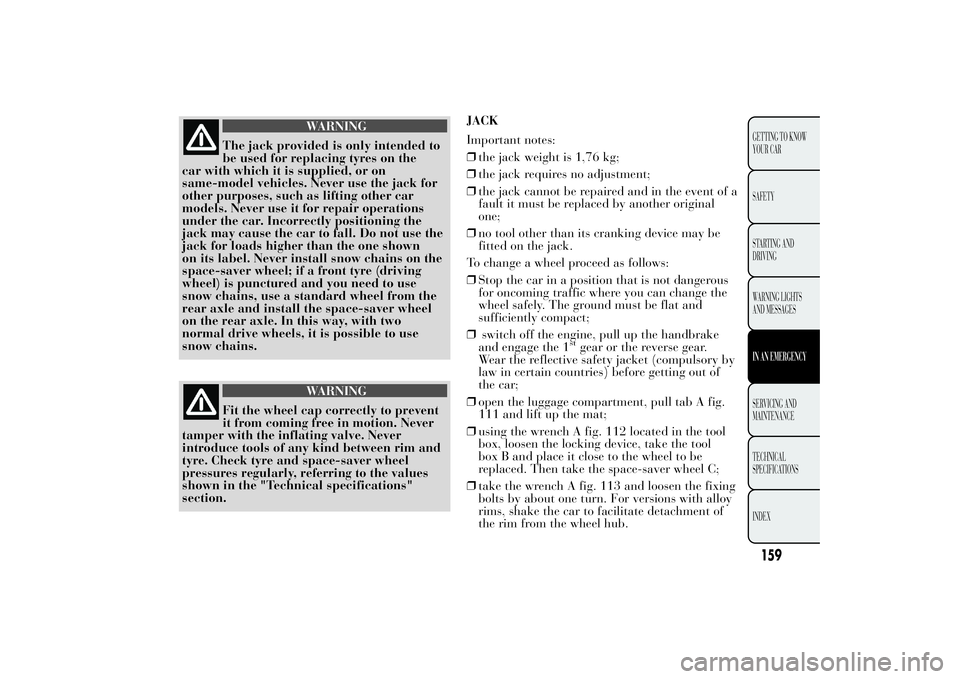
WARNING
The jack provided is only intended to
be used for
replacing tyres on the
car with which it is supplied, or on
same-model vehicles. Never use the jack for
other purposes, such as lifting other car
models. Never use it for repair operations
under the car. Incorrectly positioning the
jack may cause the car to fall. Do not use the
jack for loads higher than the one shown
on its label. Never install snow chains on the
space-saver wheel; if a front tyre (driving
wheel) is punctured and you need to use
snow chains, use a standard wheel from the
rear axle and install the space-saver wheel
on the rear axle. In this way, with two
normal drive wheels, it is possible to use
snow chains.
WARNING
Fit the wheel cap correctly to prevent
it from coming
free in motion. Never
tamper with the inflating valve. Never
introduce tools of any kind between rim and
tyre. Check tyre and space-saver wheel
pressures regularly, referring to the values
shown in the "Technical specifications"
section.JACK
Important notes:
❒the jack weight is 1,76 kg;
❒the jack requires no adjustment;
❒the jack cannot be repaired and in the event of a
fault it must be replaced by another original
one;
❒no tool other than its cranking device may be
fitted on the jack.
To change a wheel proceed as follows:
❒Stop the car in a position that is not dangerous
for oncoming traffic where you can change the
wheel safely. The ground must be flat and
sufficiently compact;
❒switch off the engine, pull up the handbrake
and engage the 1
stgear or the reverse gear.
Wear the reflective safety jacket (compulsory by
law in certain countries) before getting out of
the car;
❒open the luggage compartment, pull tab A fig.
111 and lift up the mat;
❒using the wrench A fig. 112 located in the tool
box, loosen the locking device, take the tool
box B and place it close to the wheel to be
replaced. Then take the space-saver wheel C;
❒take the wrench A fig. 113 and loosen the fixing
bolts by about one turn. For versions with alloy
rims, shake the car to facilitate detachment of
the rim from the wheel hub.
159GETTING TO KNOW
YOUR CAR
SAFETY
STARTING AND
DRIVING
WARNING LIGHTS
AND MESSAGESIN AN EMERGENCYSERVICING AND
MAINTENANCE
TECHNICAL
SPECIFICA
TIONS
INDEX
Page 167 of 299

Dispose of the bottle and the sealant
liquid properly. Have the sealing fluid
and the cylinder disposed of in
compliance with national and local
regulations.
INFLATING PROCEDURE
WARNING
Put on the protective gloves provided
together with quick
tyre repair kit.
Proceed as follows:
❒Pull up the handbrake.Unscrew the tyre
valve cap, take out the flexible filler pipe A fig.
120 and tighten the ring nut B on the tyre valve;❒make sure that the compressor switch A fig. 121
is in position 0 (off), start the engine, plug into
the power socket in the central tunnel fig. 122
and operate the compressor turning switch A to
position I (on). Inflate the tyre to the pressure
specified in the "Tyre pressure" paragraph
in the "Technical specifications" section. Check
tyre pressure on gauge B fig. 121 with
compressor off to obtain a more precise reading;
❒if after five minutes it is still impossible to reach
at least 1.8 bar, disengage the compressor from
the valve and power socket, then move the
car forwards by approx. ten metres in order to
distribute the sealing fluid inside the tyre evenly,
then repeat the inflation operation;
❒if after this operation you still cannot reach at
least 1.8 bar after 5 minutes from switching
on the compressor, do not resume driving but
contact a Lancia Dealership;
fig. 120
L0F0176
fig. 121
L0F0181
165GETTING TO KNOW
YOUR CAR
SAFETY
STARTING AND
DRIVING
WARNING LIGHTS
AND MESSAGESIN AN EMERGENCYSERVICING AND
MAINTENANCE
TECHNICAL
SPECIFICA
TIONS
INDEX
Page 168 of 299

WARNING
Apply the adhesive label where it can
be easily seen
by the driver as a
reminder that the tyre has been treated with
the tyre quick repair kit. Drive carefully,
particularly on bends. Do not exceed 80
km/h. Do not accelerate or brake suddenly.
❒after driving for about 10 minutes stop and
check the tyre pressure again;pull up the
handbrake;For the safety of the car when it is
parked, follow the indication in the paragraph
"When parked" in the chapter "Starting up and
driving" .
WARNING
If the pressure has fallen below 1.8
bar, do
not drive any further: the
automatic tyre quick repair kit cannot
guarantee the correct hold because the tyre
is too damaged. Contact a Lancia
Dealership.
❒if a pressure value of at least 1.8 bar is detected,
restore the correct pressure (with the engine
running and the handbrake engaged), resume
driving and drive with care to nearest Lancia
Dealership.
WARNING
Inform the dealership that the tyre
has been repaired
using the tyre
quick repair kit. Give the instruction booklet
to the personnel charged with handling the
treated tyre.
fig. 122
L0F0178
166
GETTING TO KNOW
YOUR CAR
SAFETY
STARTING AND
DRIVING
WARNING LIGHTS
AND MESSAGESIN AN EMERGENCYSERVICING AND
MAINTENANCE
TECHNICAL
SPECIFICA
TIONS
INDEX
Page 200 of 299
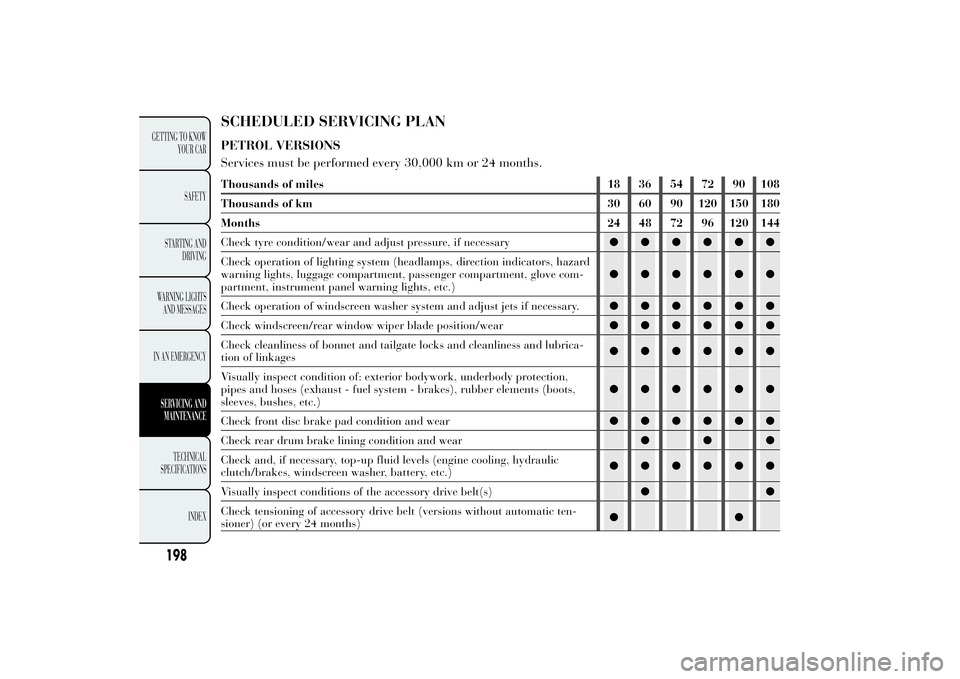
SCHEDULED SERVICING PLANPETROL VERSIONS
Services must be performed every 30,000 km or 24 months.Thousands of miles 18 36 54 72 90 108
Thousands of km 30 60 90 120 150 180
Months 24 48 72 96 120 144
Check tyre condition/wear and adjust pressure, if necessary●●●●●●
Check operation of lighting system (headlamps, direction indicators, hazard
warning lights, luggage compartment, passenger compartment, glove com-
partment, instrument panel warning lights, etc.)●●●●●●
Check operation of windscreen washer system and adjust jets if necessary.●●●●●●
Check windscreen/rear window wiper blade position/wear●●●●●●
Check cleanliness of bonnet and tailgate locks and cleanliness and lubrica-
tion of linkages●●●●●●
Visually inspect condition of: exterior bodywork, underbody protection,
pipes and hoses (exhaust - fuel system - brakes), rubber elements (boots,
sleeves, bushes, etc.)●●●●●●
Check front disc brake pad condition and wear●●●●●●
Check rear drum brake lining condition and wear●●●
Check and, if necessary, top-up fluid levels (engine cooling, hydraulic
clutch/brakes, windscreen washer, battery, etc.)●●●●●●
Visually inspect conditions of the accessory drive belt(s)●●
Check tensioning of accessory drive belt (versions without automatic ten-
sioner) (or every 24 months)●●
198
GETTING TO KNOW
YOUR CAR
SAFETY
STARTING AND
DRIVING
WARNING LIGHTS
AND MESSAGES
IN AN EMERGENCYSERVICING AND
MAINTENANCE
TECHNICAL
SPECIFICA
TIONS
INDEX
Page 201 of 299
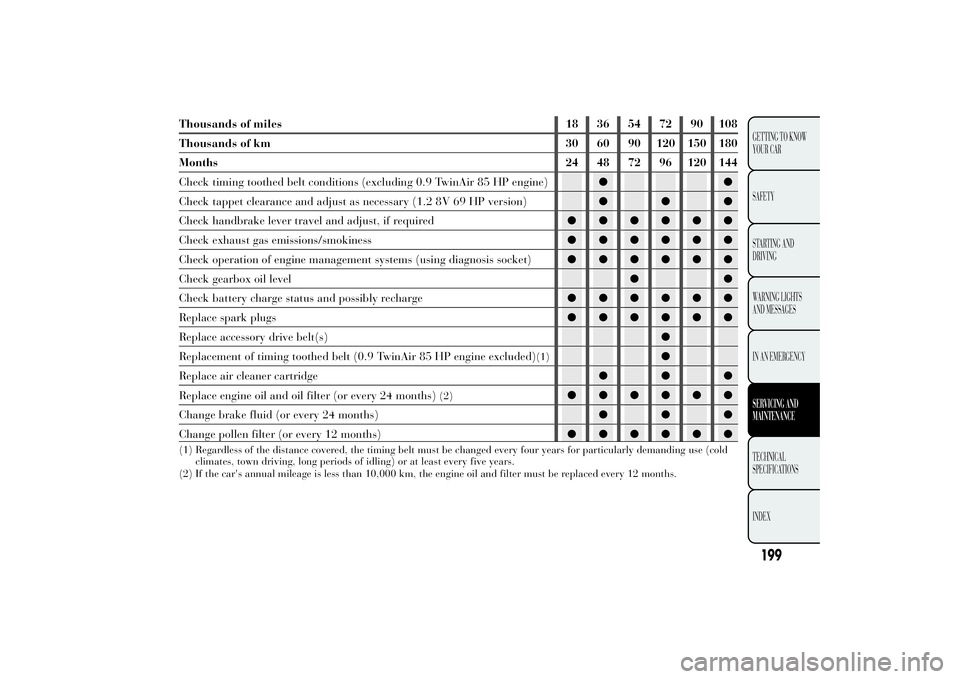
Thousands of miles 18 36 54 72 90 108
Thousands of km 30 60 90 120 150 180
Months 24 48 72 96 120 144
Check timing toothed belt conditions (excluding 0.9 TwinAir 85 HP engine)●●
Check tappet clearance and adjust as necessary (1.2 8V 69 HP version)●●●
Check handbrake lever travel and adjust, if required●●●●●●
Check exhaust gas emissions/smokiness●●●●●●
Check operation of engine management systems (using diagnosis socket)●●●●●●
Check gearbox oil level●●
Check battery charge status and possibly recharge●●●●●●
Replace spark plugs●●●●●●
Replace accessory drive belt(s)●
Replacement of timing toothed belt (0.9 TwinAir 85 HP engine excluded)
(1)
●
Replace air cleaner cartridge●●●
Replace engine oil and oil filter (or every 24 months)
(2)
●●●●●●
Change brake fluid (or every 24 months)●●●
Change pollen filter (or every 12 months)●●●●●●
(1) Regardless of the distance covered, the timing belt must be changed every four years for particularly demanding use (cold
climates, town driving, long periods of idling) or at least every five years.
(2) If the car's annual mileage is less than 10,000 km, the engine oil and filter must be replaced every 12 months.
199GETTING TO KNOW
YOUR CAR
SAFETY
STARTING AND
DRIVING
WARNING LIGHTS
AND MESSAGES
IN AN EMERGENCYSERVICING AND
MAINTENANCETECHNICAL
SPECIFICA
TIONS
INDEX
Page 202 of 299
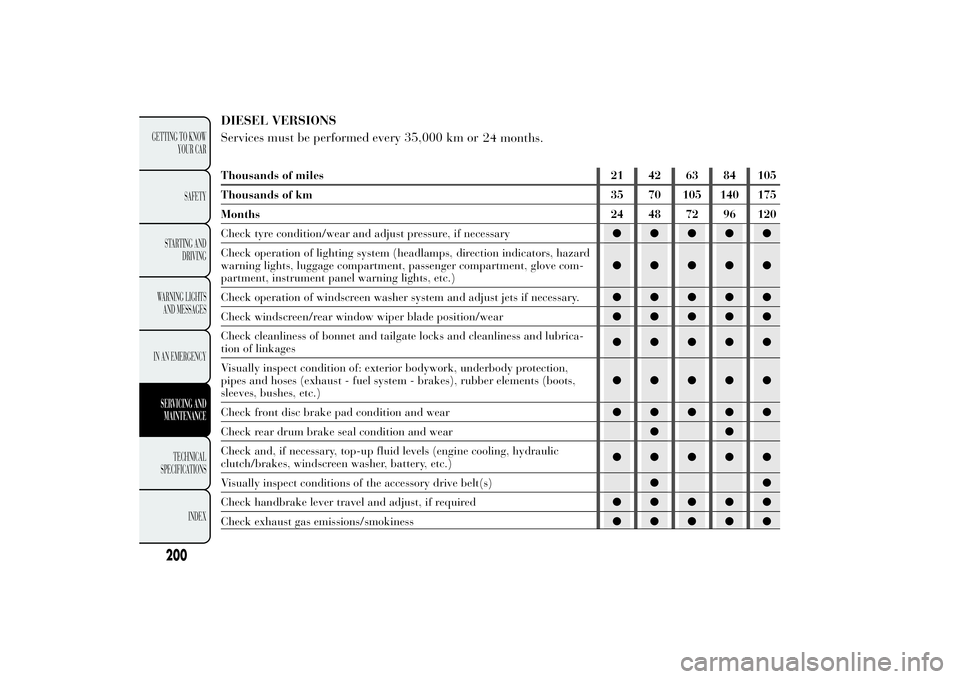
DIESEL VERSIONS
Services must be performed every 35,000 km or
24 months.Thousands of miles 21 42 63 84 105
Thousands of km 35 70 105 140 175
Months 24 48 72 96 120
Check tyre condition/wear and adjust pressure, if necessary●●●●●
Check operation of lighting system (headlamps, direction indicators, hazard
warning lights, luggage compartment, passenger compartment, glove com-
partment, instrument panel warning lights, etc.)●●●●●
Check operation of windscreen washer system and adjust jets if necessary.●●●●●
Check windscreen/rear window wiper blade position/wear●●●●●
Check cleanliness of bonnet and tailgate locks and cleanliness and lubrica-
tion of linkages●●●●●
Visually inspect condition of: exterior bodywork, underbody protection,
pipes and hoses (exhaust - fuel system - brakes), rubber elements (boots,
sleeves, bushes, etc.)●●●●●
Check front disc brake pad condition and wear●●●●●
Check rear drum brake seal condition and wear●●
Check and, if necessary, top-up fluid levels (engine cooling, hydraulic
clutch/brakes, windscreen washer, battery, etc.)●●●●●
Visually inspect conditions of the accessory drive belt(s)●●
Check handbrake lever travel and adjust, if required●●●●●
Check exhaust gas emissions/smokiness●●●●●
200
GETTING TO KNOW
YOUR CAR
SAFETY
STARTING AND
DRIVING
WARNING LIGHTS
AND MESSAGES
IN AN EMERGENCYSERVICING AND
MAINTENANCE
TECHNICAL
SPECIFICA
TIONS
INDEX
Page 203 of 299
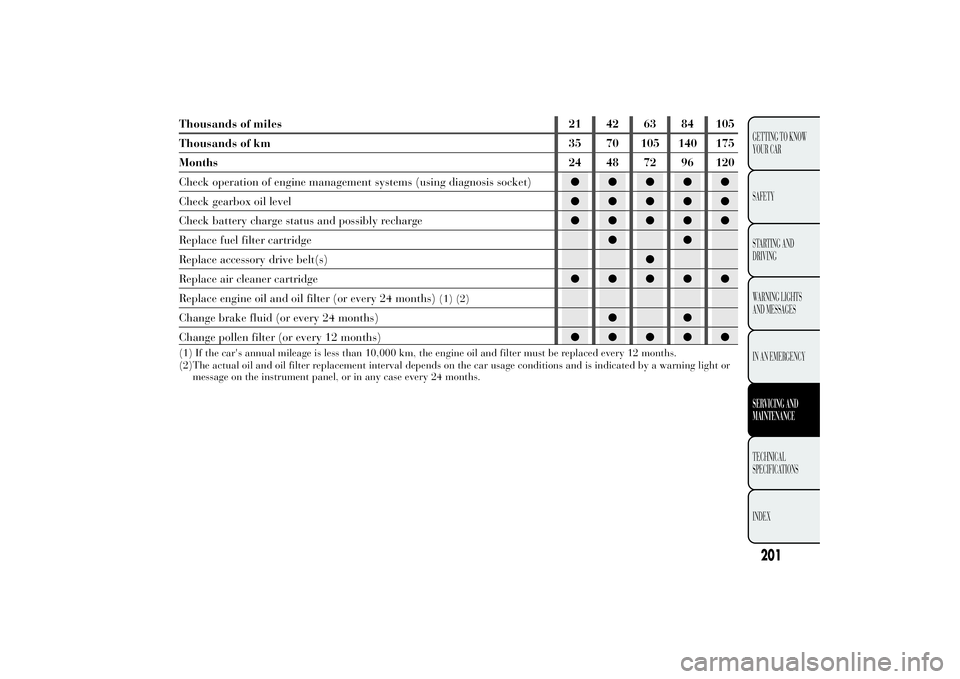
Thousands of miles 21 42 63 84 105
Thousands of km 35 70 105 140 175
Months 24 48 72 96 120
Check operation of engine management systems (using diagnosis socket)●●●●●
Check gearbox oil level●●●●●
Check battery charge status and possibly recharge●●●●●
Replace fuel filter cartridge●●
Replace accessory drive belt(s)●
Replace air cleaner cartridge●●●●●
Replace engine oil and oil filter (or every 24 months)
(1) (2)
Change brake fluid (or every 24 months)●●
Change pollen filter (or every 12 months)●●●●●(1) If the car's annual mileage is less than 10,000 km, the engine oil and filter must be replaced every 12 months.
(2)The actual oil and oil filter replacement interval depends on the car usage conditions and is indicated by a warning light or
message on the instrument panel, or in any case every 24 months.
201GETTING TO KNOW
YOUR CAR
SAFETY
STARTING AND
DRIVING
WARNING LIGHTS
AND MESSAGES
IN AN EMERGENCYSERVICING AND
MAINTENANCETECHNICAL
SPECIFICA
TIONS
INDEX
Page 204 of 299
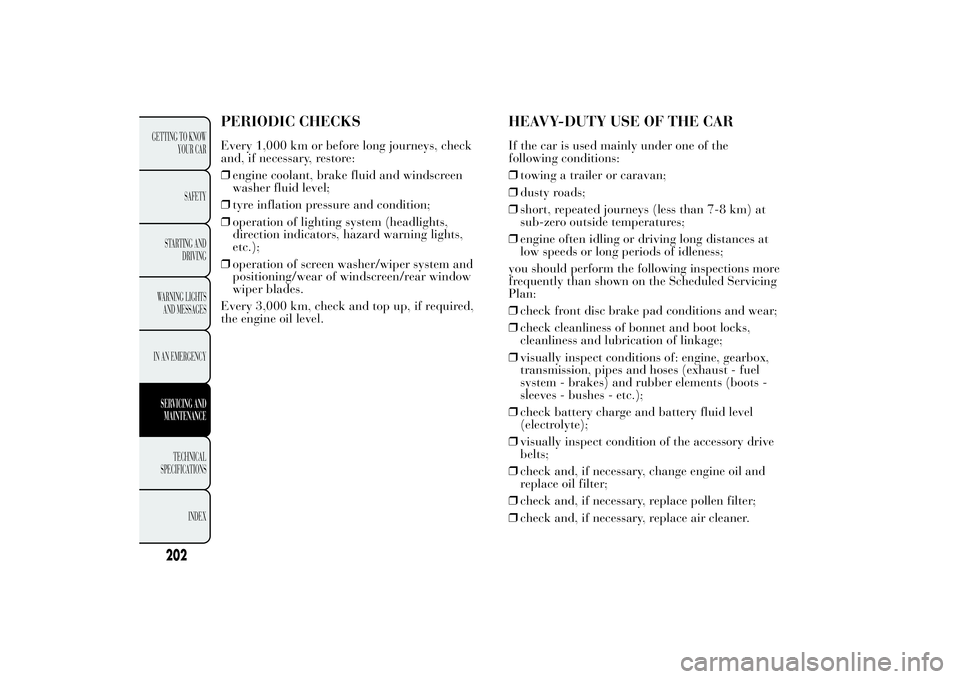
PERIODIC CHECKSEvery 1,000 km or before long journeys, check
and, if necessary, restore:
❒engine coolant, brake fluid and windscreen
washer fluid level;
❒tyre inflation pressure and condition;
❒operation of lighting system (headlights,
direction indicators, hazard warning lights,
etc.);
❒operation of screen washer/wiper system and
positioning/wear of windscreen/rear window
wiper blades.
Every 3,000 km, check and top up, if required,
the engine oil level.
HEAVY-DUTY USE OF THE CARIf the car is used mainly under one of the
following conditions:
❒towing a trailer or caravan;
❒dusty roads;
❒short, repeated journeys (less than 7-8 km) at
sub-zero outside temperatures;
❒engine often idling or driving long distances at
low speeds or long periods of idleness;
you should perform the following inspections more
frequently than shown on the Scheduled Servicing
Plan:
❒check front disc brake pad conditions and wear;
❒check cleanliness of bonnet and boot locks,
cleanliness and lubrication of linkage;
❒visually inspect conditions of: engine, gearbox,
transmission, pipes and hoses (exhaust - fuel
system - brakes) and rubber elements (boots -
sleeves - bushes - etc.);
❒check battery charge and battery fluid level
(electrolyte);
❒visually inspect condition of the accessory drive
belts;
❒check and, if necessary, change engine oil and
replace oil filter;
❒check and, if necessary, replace pollen filter;
❒check and, if necessary, replace air cleaner.
202
GETTING TO KNOW
YOUR CAR
SAFETY
STARTING AND
DRIVING
WARNING LIGHTS
AND MESSAGES
IN AN EMERGENCYSERVICING AND
MAINTENANCE
TECHNICAL
SPECIFICA
TIONS
INDEX